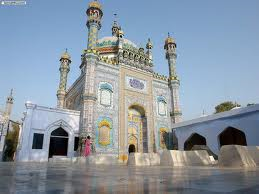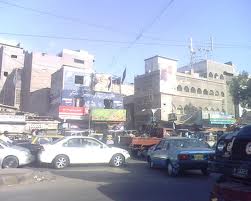According to legend, the city started as a fishing settlement, where a fisherwoman,
Mai Kolachi, settled and started a family. The village that grew out of this settlement was known as Kolachi-jo-Goth (The Village of Kolachi in
Sindhi). When Sindh started trading across the sea with
Muscat and the Persian Gulf in the late 18th century, Karachi gained in importance; a small fort was constructed for its protection with a few cannons imported from Muscat. The fort had two main gateways: one facing the sea, known as Khara Dar (Brackish Gate) and the other facing the adjoining Lyari river, known as the Meetha Dar (Sweet Gate). The location of these gates corresponds to the present-day city localities of Khaaradar (
Khārā Dar) and Meethadar (
Mīṭhā Dar) respectively.
The name Karachee appears for the first time in a 1742 document of the Dutch East India Company, when a ship, the Ridderkerk, was shipwrecked along the coast nearby
Talpur Period (1795 – 1839)
In 1795, Kolachi-jo-Goth passed from the control of the
Khan of Kalat,
Kalat to the
Talpur rulers of Sindh. The British, venturing and enterprising in South Asia opened a small factory here in September 1799, but it was closed down within a year because of disputes with the ruling Talpurs. However, this village by the mouth of the
Indus river had caught the attention of the
British East India Company, who, after sending a couple of exploratory missions to the area, conquered the town on February 3, 1839.
[citation needed]Company Rule (1839 – 1858)
After sending a couple of exploratory missions to the area, the
British East India Company conquered the town on February 3, 1839. The town was later annexed to the
British Indian Empire when
Sindh was conquered by
Charles James Napier in
Battle of Miani on February 17, 1843. Karachi was made the capital of Sindh in the 1840s. On Napier’s departure it was added along with the rest of Sindh to the
Bombay Presidency, a move that caused considerable resentment among the native Sindhis. The British realised the importance of the city as a military cantonment and as a port for exporting the produce of the
Indus River basin, and rapidly developed its harbour for shipping. The foundations of a city municipal government were laid down and infrastructure development was undertaken. New businesses started opening up and the population of the town began rising rapidly.
The arrival of troops of the Kumpany Bahadur in 1839 spawned the foundation of the new section, the military cantonment. The cantonment formed the basis of the ‘white’ city where the Indians were not allowed free access. The ‘white’ town was modeled after English industrial parent-cities where work and residential spaces were separated, as were residential from recreational places.
Karachi was divided into two major poles. The ‘black’ town in the northwest, now enlarged to accommodate the burgeoning Indian mercantile population, comprised the Old Town, Napier Market and Bunder, while the ‘white’ town in the southeast comprised the Staff lines, Frere Hall, Masonic lodge, Sindh Club, Governor House and the Collectors Kutchery [Law Court]
//[citation needed] located in the Civil Lines Quarter. Saddar bazaar area and Empress Market were used by the ‘white’ population, while the Serai Quarter served the needs of the ‘black’ town.
The British realized its importance as a military cantonment and a port for the produce of the
Indus basin, and rapidly developed its harbor for shipping. The foundation of a city municipal committee was laid down by the Commissioner in Sinde,
Bartle Frere and infrastructure development was undertaken. Consequently, new businesses started opening up and the population of the town started rising rapidly. Karachi quickly turned into a city, making true the famous quote by Napier who is known to have said:
Would that I could come again to see you in your grandeur!In 1857, the
Indian Mutiny broke out in the
South Asia and the 21st Native Infantry stationed in Karachi declared allegiance to rebels, joining their cause on 10 September 1857. Nevertheless, the British were able to quickly reassert control over Karachi and defeat the uprising. Karachi was known as
Khurachee Scinde (i.e. Karachi, Sindh) during the early British colonial rule.
Pakistan’s capital (1947-1958)
District Karachi was chosen as the capital city of Pakistan and accommodated a huge influx of migrants and refugees from India to the newly formed country. As a consequence, the demographics of the city also changed drastically. However, it still maintained a great cultural diversity as its new inhabitants arrived from the different parts of the India. In 1958, the capital of Pakistan was shifted from Karachi to
Islamabad and Karachi became the capital of Sindh. Large no. of rufugees migrated from India and embarked Karachi as the city of lights.
Cosmopolitan City (1958-1980)
This marked the start of a long period of decline in the city due to settlement of huge crowds of illegal refugees from other parts of the world. The city’s population continued to grow exceeding the capacity of its creaking infrastructure and increased the pressure on the city.
During the 1960s, Karachi was seen as an economic role model around the world. Many countries sought to emulate Pakistan’s economic planning strategy and one of them, South Korea, copied the city’s second “Five-Year Plan” and World Financial Centre in Seoul is designed and modeled after Karachi.
The 1970s saw major labour struggles in Karachi’s industrial estates, (see:
Karachi labour unrest of 1972) During General Zia Ul Haq’s Martial Law, Karachi saw relative peace and prosperity, specially during the 3 years of Major General Mahmood Aslam Hayat, as Deputy Martial Law Administrator Karachi from 1977 to 1980
Post 1970s (1980-Present)
The 1980s and 90’s also saw an influx of illegal
Afghan refugees from the Afghan war into Karachi, and the city now also called, a “city of illegal refugees”. Political tensions between the
Muhajir and other groups also erupted and the city was wracked with political violence. The period from 1992 to 1994 is regarded as the bloodiest period in the history of the city, when the Army commenced its
Operation Clean-up against the
Mohajir Qaumi Movement.
Since the last couple of years however, most of these tensions have largely been quieted. Karachi continues to be an important financial and industrial centre for the Sindh and handles most of the overseas trade of Pakistan and the
Central Asian countries.
[citation needed] It accounts for a large portion of the
GDP of Sindh, Pakistan and a large chunk of the country’s white collar workers. Karachi’s population has continued to grow and is estimated to have exceeded 15 million people. Currently, Karachi is a melting pot where people from all the different parts of
Pakistan,
Afghanistan,
Bangladesh,
Iran and
India. The Sindh government is undertaking a massive upgrading of the city’s infrastructure which promises to again put this heart of Sindh city of Karachi into the lineup of one of the world’s greatest metropolitan cities.
The last census was held on 1998, the current estimated Population ratio of 2012 is :
Urdu: 41.52% Pashto: 18.96% Punjabi: 15.64% Sindhi: 10.34% Balochi: 06.34% Saraiki: 04.11% Others: 03.09%. The others include Konkani, Kuchhi, Gujarati, Dawoodi Bohra, Memon, Brahui, Makrani, Khowar, Burushaski, Arabic, Persian and Bengali.[84].
[3]





